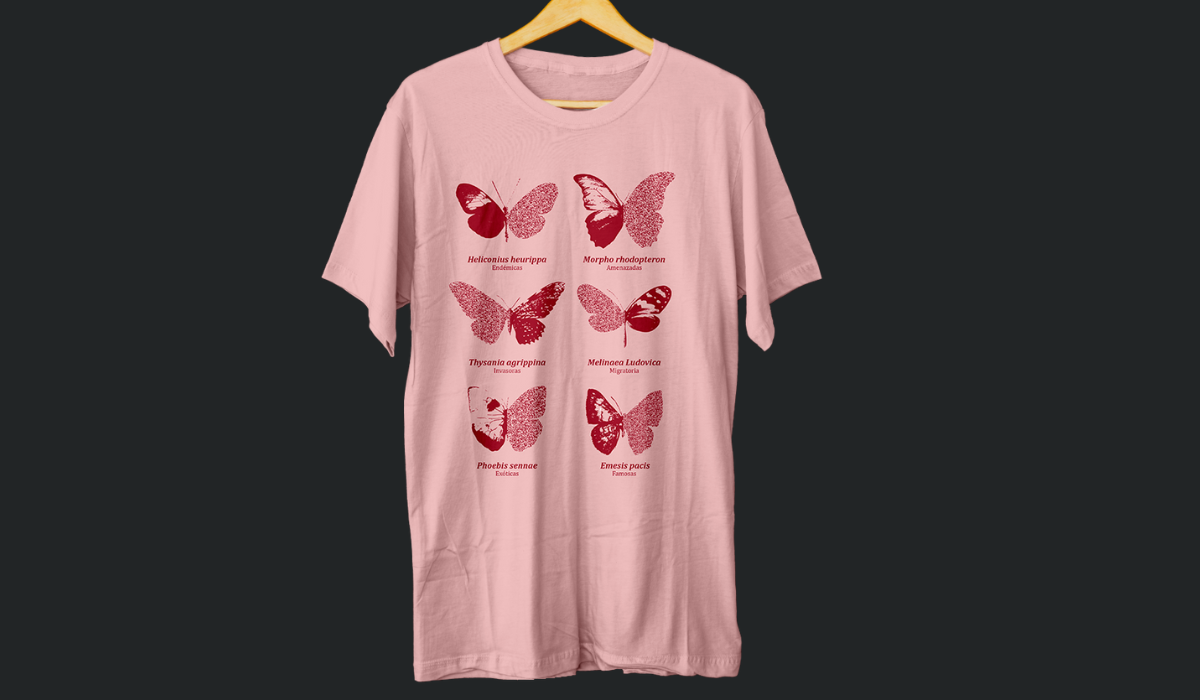
This design highlights the incredible diversity of butterflies in Colombia, emphasizing its position as the number one country in the world for species variety. Scan the QR code to learn more about some endemic, endangered, venomous butterflies, and other fascinating facts about these insects.
Endemic Species
Out of the total number of species found in Colombia, 81 are endemic, meaning they are only found in this territory. This makes them particularly significant for global biodiversity and scientific research on these lepidopterans. The Idioneurula Erebioides, Pedaliodes Phaea, and Pedaliodes Rodriguezi rank as the top three endemic butterfly species with the highest number of records nationwide. These species are found in the departments of Boyacá, Cundinamarca, and Meta.
Sources: cifras.biodiversidad.co, gbif.org, catalogo.biodiversidad.co
Sources: https://cifras.biodiversidad.co/, https://www.gbif.org/, https://catalogo.biodiversidad.co/
Endangered Species
Six butterfly species are currently threatened in Colombia: the Arhuaco Ica, Lymanopoda Caeruleata, Lymanopoda Paramera, Morpho Rhodopteron, Prepona Praeneste, and Prepona Werneri. The main threats they face include deforestation due to agricultural expansion, livestock farming, tree cutting, and illicit crops. A species is considered threatened when its natural populations are at risk of disappearing based on criteria such as:
- Rapid reduction in population size.
- Small, fragmented, diminishing, or fluctuating range.
- Small and declining population.
- Very small population or area, or population viability analysis. Sources: https://cifras.biodiversidad.co/, https://www.gbif.org/, https://catalogo.biodiversidad.co/
Famous/Popular/Visually Striking Species
Some butterfly species have gained fame due to their emblematic role and national significance. One such species is the Butterfly of Peace, or the Colombian Pacific Butterfly. Its scientific name is Emesis Pacis, and it was named in honor of peace, symbolizing the historical context of the end of the armed conflict following the Havana Peace Agreement at the time of its discovery. It inhabits the cloud forests of the western mountain range at altitudes above 1,900 meters, in the departments of Antioquia, Risaralda, Valle del Cauca, and Chocó. Sources: https://www.humboldt.org.co/, https://colombia.inaturalist.org/
Exotic Species
The White Witch, the Emperor Butterfly, and the Black Witch are some of the exotic butterflies in Colombia, and all three are among the largest insects in the world. Their uniqueness is associated with characteristics such as their wing patterns, colors, and nocturnal behavior. They play a crucial role in their habitats as they pollinate flowers and serve as food for other species such as birds and bats.
Sources: https://www.humboldt.org.co/noticias/colecciones
Migratory Species
The Yellow Butterfly is the popular name for the migratory species typical of the Caribbean. They are the most famous butterflies in Colombia after their appearance in Gabriel García Márquez’s novel One Hundred Years of Solitude, as they not only symbolize the constant fluttering that marks the impossible love story between Renata Remedios Buendía and Mauricio Babilonia, but they also became an emblem of magical realism and Colombian culture worldwide.
Sources: https://centrogabo.org/, https://mexico.inaturalist.org/, https://enciclovida.mx/, https://www.banrepcultural.org/
Venomous Species
Given the large number of butterfly species in Colombia, there are also venomous ones. These butterflies have developed the ability to store toxic chemical compounds as a defense mechanism, which they activate in the presence of predators. Their toxicity makes them lethal and unattractive to consumption, forming a fascinating and essential group for ecosystem balance. Sources: https://mariposasdecolombia.top, http://vip.ucaldas.edu.co/boletincientifico/downloads/Boletin26(1)\_Completo.pdf
Ecological Importance
Butterflies play crucial roles in ecosystems:
Pollination: They significantly contribute to the reproduction of various plant species. Food Chain: They serve as a food source for multiple species of birds, bats, and other predators. Biological Control: Caterpillars regulate the populations of certain plants. Bioindicators: Their presence or absence can indicate changes in environmental conditions, providing valuable information on species adaptation and ecosystem responses to environmental changes like deforestation or pollution. Ecosystem Balance: They engage in multiple ecological interactions that maintain habitat stability.
5 Relevant Facts About Butterflies
Flight Ability: Some species can reach speeds of up to 50 kilometers per hour, allowing them to cover large distances during migration. Sensory System: Their taste organs are located on their feet, enabling them to identify suitable plants for laying eggs through direct contact. Visual Perception: Their visual system can detect wavelengths in the ultraviolet spectrum, surpassing human vision and helping them identify floral resources. Metamorphosis Process: During metamorphosis, the caterpillar’s tissues undergo complete cellular reorganization before developing the adult structures. Altitude Adaptation: Some species have developed physiological adaptations to survive in high-altitude ecosystems, above 4,000 meters above sea level
These facts help us understand and protect butterflies, an essential species for maintaining biodiversity and conserving the ecological balance of the country!